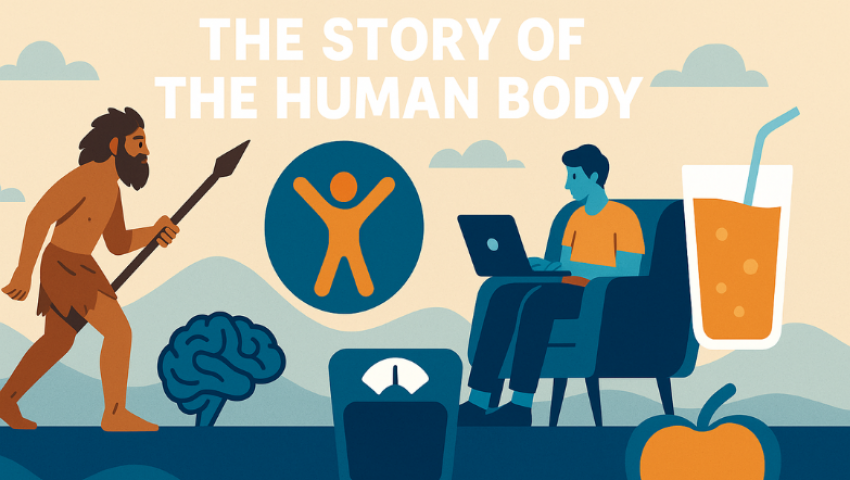
Modern Bodies, Ancient Systems: Business Lessons from Evolutionary Mismatch
Discover how The Story of the Human Body by Daniel Lieberman reveals powerful insights on adaptation, systems failure, and long-term resilience — and what modern organizations can learn from evolutionary biology to stay relevant in an ever-changing world.
What Stone Age Bodies Teach Us About Strategy
What if your team — or your entire business — was running on instincts designed for a world that no longer exists?
That’s the essential insight behind Daniel Lieberman’s The Story of the Human Body, a book that explores how the human body evolved for survival in pre-modern, physically demanding environments — and what happens when it is placed in today’s hyper-automated, overstimulated, comfort-optimized world.
At Maldicore, we believe this evolutionary mismatch mirrors the challenge many businesses face today: systems that once worked are now counterproductive, even harmful. The book offers profound metaphors for leaders designing adaptive, resilient, human-centered organizations.
1. The Mismatch Problem — In Biology and Business
Lieberman writes:
"We were selected to have as many offspring as possible under diverse, challenging conditions — not to thrive in a world of couches, escalators, and endless calories."
Our bodies are still calibrated for scarcity, effort, and vigilance. Yet we live in abundance, convenience, and distraction. The result? Obesity, chronic fatigue, autoimmune disorders — modern illnesses born from ancient programming.
Examples from the book:
- Craving sugar helped ancient humans survive famine. Today, it leads to diabetes.
- Avoiding stairs conserved energy in the wild. Today, it contributes to cardiovascular disease.
- The immune system once needed constant exposure to parasites and dirt. In sterile environments, it often turns on itself.
Business parallel:
Many organizations operate on old instincts:
- Hoarding information
- Avoiding risk at all costs
- Optimizing for short-term survival over long-term adaptability
Maldicore Insight: You must update your operating system — not just your interface.
2. Comfort Kills: Ancient Wiring, Modern Burnout
Lieberman explains how energy conservation — once a life-saving behavior — now causes stagnation:
“We are wired to avoid effort. This instinct kept us alive. Now it’s slowly destroying us.”
Real-world insight:
- 96% of people choose escalators over stairs.
- We sit for 9+ hours a day.
- Physical exertion is no longer embedded into life—it’s outsourced to gyms (and even that’s declining).
Organizational parallel:
Corporate cultures that over-prioritize comfort (zero accountability, overstaffing, endless policies) become sluggish and disconnected from results.
Maldicore Perspective:
High-performing systems require tension, effort, and energy circulation — just like healthy bodies.
3. The Fiber Crisis = The Feedback Crisis
Lieberman calls out the fiber gap — hunter-gatherers consumed 40+ pounds annually. Today’s average is under 10.
Why it matters:
Fiber isn't just about digestion. It slows sugar absorption, prevents insulin spikes, and feeds gut health — in short, it keeps the whole system in balance.
Business analogy:
Fiber = Friction + Feedback
Without honest reporting, customer insight, or team accountability, companies develop organizational inflammation:
- Overreactions
- Cultural toxicity
- Lack of strategic clarity
Maldicore Lesson:
Systemic feedback loops are essential. Add structure that regulates and stabilizes — don’t just automate and accelerate.
4. Movement Is Mandatory — Not Optional
Lieberman shows how movement was once built into every aspect of daily life:
- Early humans walked 5–10 miles daily — without weekends or retirement.
- Today’s lack of motion causes bone degradation, brain fog, and reduced lifespan.
Business metaphor:
Organizations need movement too — iterative cycles, learning rhythms, and real progress.
A strategy that’s never reviewed, a process never optimized, a team never restructured = institutional decay.
Maldicore’s view:
Action isn’t noise. It’s how systems stay alive.
5. Systemic Problems Need Systemic Solutions
Lieberman warns against treating symptoms.
We medicate depression without questioning the societal conditions causing it.
We treat Type 2 diabetes without examining ultra-processed food systems.
Corporate parallel:
We install CRMs instead of solving customer neglect.
We launch culture campaigns while leadership incentives remain toxic.
Maldicore Application:
We call this strategic infusion — embedding health into the roots, not just painting the leaves.
6. Sleep Isn’t Broken — The System Is Misaligned
Lieberman explains that modern sleep advice misreads ancient patterns:
- Early humans slept at dusk, in groups, with mid-night interruptions and daytime naps.
- Today’s isolated, silent, 8-hour sleep goal is entirely unnatural — no wonder people feel broken.
Strategy takeaway:
You can’t force systems into idealized forms. You have to understand natural patterns and design accordingly.
Business implication:
Maybe it’s not your team that’s broken. Maybe it’s the unnatural rhythms you’re forcing them into.
7. The Simple (Hard) Truth About Health and Growth
Lieberman doesn’t offer magic bullets. His advice:
“Don’t eat sugar and get plenty of exercise.”
Simple. Timeless. Hard to sell — but it works.
Organizational truth:
- Real performance comes from clarity, consistency, and accountability.
- Strategy is simple: listen better, act faster, align continuously.
At Maldicore, we build simplicity with structure — not shortcuts.
Rethinking Strategy Like a Biologist
What Lieberman teaches about the body applies to businesses:
- Evolve or decay
- Move or stagnate
- Listen or collapse
The evolutionary model reminds us: if your system is mismatched with your environment, you're not just inefficient — you're in danger.
The Future Belongs to the Adaptable
Organizations that adapt their culture, rhythms, and systems to modern conditions will thrive.
Those that run legacy playbooks in a transformed world… won’t.
Don’t build strategy from preference. Build it from principles rooted in reality.
The Story of the Human Body isn’t a health book — it’s a wake-up call for leaders who want their businesses to survive the next stage of human evolution.
Read “The Story of the Human Body” — but more importantly, use it as a mirror.
Ask yourself: Are we optimizing for the world we’re in — or the one we left behind?

Maldicore Support
Leave a comment
Your email address will not be published. Required fields are marked *

